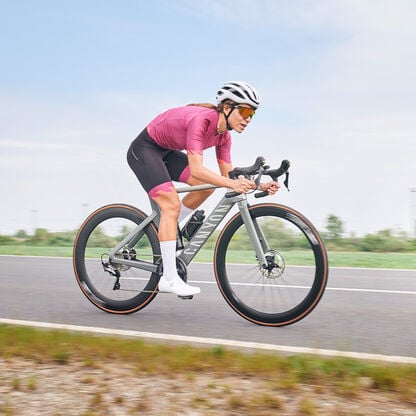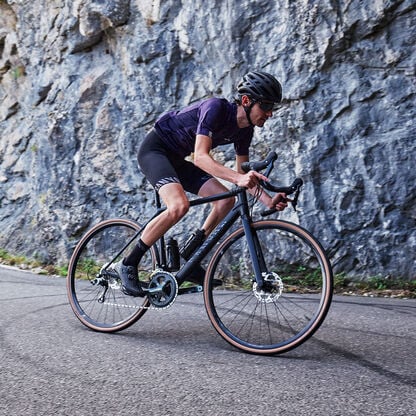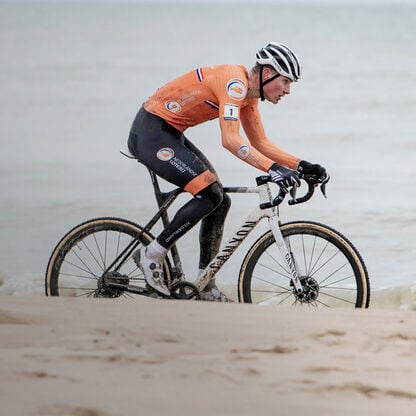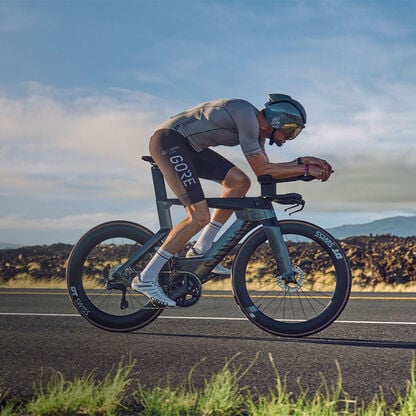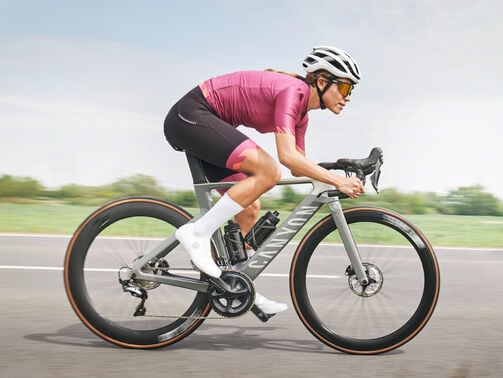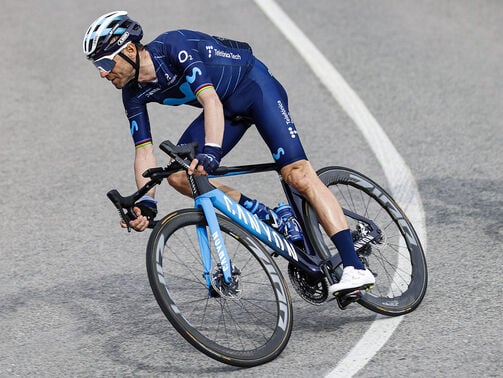Aeroad or Ultimate: Which is better for you?
Which is faster – a lighter weight or more aerodynamic bicycle? More importantly, which is the right bike for you?
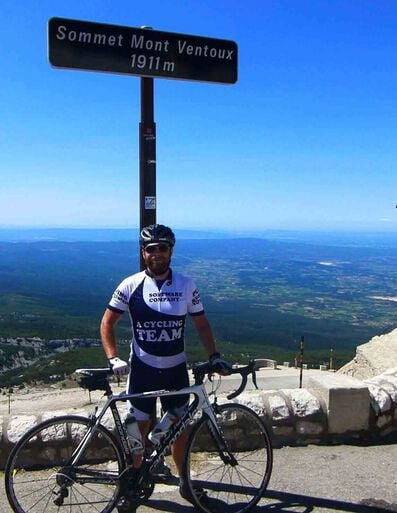

It’s a good, albeit tough, dilemma to have – which Canyon road-racing bike is best for you? (Luckily, finding the right road bike for you has never been easier with Canyon’s road bike buyer’s guide.) The Canyon Ultimate is a true racing machine, as fast on the climbs as it is on level ground. The Aeroad slices through the wind like you slice through the rest of the field on this bike. Designed to be the most aerodynamic bike in the professional peloton, it’s also the preferred ride of world road-racing champion Mathieu van der Poel.
Contents
Understanding geometry: Aeroad vs. Ultimate differences
A road bike's geometry is responsible for its ride characteristics. The stack – the vertical height from the bottom bracket to the head tube – and reach – the horizontal distance between the center of the bottom bracket and the head tube – are key. The bigger stack number, the more upright your riding position. An increased reach means a longer riding position, which is key for a race bike. Likewise, shorter chainstays help a bike feel twitchier and more responsive.
When looking at the Ultimate and Aeroad SLX 8 Ultegra Di2 models in a size medium, the numbers are strikingly similar. Both the Aeroad and Ultimate have the same stack height (560mm), reach (393mm), chainstays (410) and wheelbase (988). The Aeroad has a slightly taller standover height (810mm) and longer top tube length (559mm) versus the Ultimate (803mm and 555mm, respectively).
What does this mean in real-world terms? Previous versions of the Aeroad had a much more aggressive geometry to take full advantage of its deep, aerodynamic tubes. But after getting feedback from the pro peloton, including Tour de France green jersey winner Jasper Phillipsen, Canyon relaxed the rider positioning, opting for the Pro Sport geometry of the Ultimate. The Aeroad’s longer top tube means riders will be stretched out ever so slightly more, putting them in a bit more of an aerodynamic pedaling position, but it’s doubtful you’ll notice much of a difference between the two when riding them.
(If you’re looking for a more relaxed, but still fast, ride, we suggest trying out the Endurace.)

Frame design comparison
Canyon engineers claim the fifth-generation Ultimate offers the perfect balance of weight, aerodynamics, stiffness, robustness, and comfort, and while the latest Aeroad model puts aerodynamics at the forefront, it’s still a comfortable, effective racing machine.
The lightweight Ultimate frame floats at the bottom of the legal UCI minimums, but still has a carbon-reinforced top tube, as well as seat and chain stays, to withstand stress from racing. Canyon uses the most advanced carbon fiber to create a bike with class-leading stiffness-to-weight ratio.
Although its tube shapes aren’t as pronounced as the Aeroad, the Ultimate frame is still one of the most aero Canyon engineers have ever designed; even the seatpost has been redesigned to keep drag to an absolute minimum. Head tube stiffness was increased by 15 percent over the previous Ultimate model, making it even more agile. It responds to the lightest movement, perfect for when you’re riding in a tight bunch and need to respond to an attack or possible crash.
The more aerodynamic tubes used on the Aeroad will save you 7.4 watts at 28mph (45kph) compared to previous generations of that model. That said, you need to ride at that speed or faster to reach those savings.
The Aeroad frame is slightly heavier, with the Ultimate SLX 8 Ultegra Di2 weighing in at 16.01 lbs. and the same Aeroad model tipping the scales at 17.38 lbs.
Technology overview: Aeroad vs. Ultimate innovations
When you purchase a Canyon bike, you’re buying years upon years worth of engineering and expertise. Canyon’s engineers and sponsored athletes collaborated with aerodynamic experts Swiss Side to create and refine the best bicycles in the world.
In previous years, riders had to make compromises about the ride they wanted. That’s no longer the case. Everything about these two models has been optimized for speed and race performance. Cable and electronics routing is completely internal.
Component comparison: Aeroad vs. Ultimate specifications
Components are going to be remarkably similar between the models. Buyers can choose between models built with quality SRAM or Shimano components, either cable-actuated or electronic. The higher-end models for both come with Canyon’s innovative CP0018 integrated handlebar and stem that allows for 40mm of width adjustment and 15mm of height adjustment that eliminates the need to saw off part of the steerer tube.
The wheels for each of the Aeroad models have a deeper profile for aerodynamic benefit, while Zipp 303s or 353s can be found on the higher-end Ultimate models. Many models for both lines are spec’d with 25mm tires at the front and 28mm tires at the rear. Wheels with 32mm tires are the maximum allowed for the Ultimate, while the Aeroad accepts up to 31mm tires.

How to make a decision?
Choosing between these two models is a fun, but nerve-wracking, task. In previous years, the terrain where you live or race would be the determining factor – if you’re in the hills or mountains, go for the lighter bike, while aerodynamics come into play more on flatter roads. But given the number of pro riders who stick with the Aeroad on all but the monster climbs, that advice may not be as valid anymore.
Luckily, there’s not really a wrong choice – both are exceptional racing bikes that will help you cross the line first, whether it’s a town-limit sign sprint during a weekend ride with your riding buddies, your local amateur criterium, or Paris-Roubaix. (You may actually have to be Mathieu van der Poel for that last one.)
For more detailed information on the specifications or if you have additional questions, be sure to check out our bike comparison tool. Just hit compare on the page, and you can choose up to two other bikes to analyze components, geometry, and more.
Still can’t decide between the two models (and you can’t afford or have the garage space for both). Try taking them for a test ride at one of Canyon’s demo centers such as the one in Carlsbad, California and test ride centers in Europe. If after a few rides you feel like you’ve made the wrong decision, you can easily exchange it, thanks to Canyon’s generous 30-day return policy.
Discover our Road Bikes
Did this article help?
Thank you for your feedback
-
 About the author
About the authorRobert Annis
Robert Annis is an award-winning outdoor-travel journalist. As an experienced writer and sport enthusiast he writes content that is inspiring with focus on road biking. You might have read Robert's articles in Bicycling, National Geographic, Outside, Travel + Leisure, Inside Hook, AARP, Midwest Living, Sierra, Hemispheres, Departures, Lonely Planet, Afar, Los Angeles Times, Chicago Tribune, RV Magazine, and Hidden Compass.

